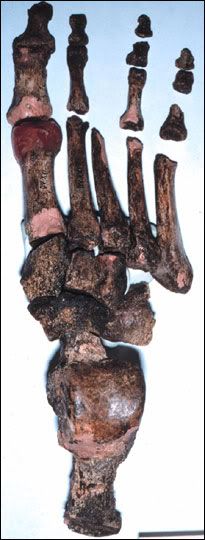Wearing sturdy shoes became all the rage between 40,000 and 30,000 years ago, according to a study of toe bones.
Erik Trinkaus, a professor of anthropology at
He focused his study on phalanges, which are the 14 toe bones. He discovered that the shape, length, placement and thickness of these bones began to change 40,000 to 30,000 years ago. Early Neanderthals and humans had very robust little toes that bent and gripped surfaces.
Trinkaus told Discovery News that "shoes reduce the mechanical stress of the lesser toes," so the four little toes do not have to do much work. He observed less substantial little-toe bones in the later skeleton samples.
Trinkaus' findings are published in the current Journal of Archaeological Science.
"All people living in very cold climates had to wear some kind of thermal protection on their feet, including Neanderthals and their predecessors," said Trinkaus. "(Supportive footwear) was part of a major explosion in human technology and cultural complexity, especially after 30,000 years ago."
To test out his theory that toe bones could be linked to sturdy shoes, Trinkaus also analyzed the feet of early Native Americans, prehistoric Alaskan Inuits and 20th century Euroamericans.
The earliest direct evidence for shoes is 9,000-year-old Native American sandals but, until the time of European contact, the Native Americans are thought to have preferred bare feet.
The Inuits, on the other hand, wore heavy boots made of stiff sealskin soles and soft, fur uppers.
As Trinkaus predicted, the Native Americans had strong, flexible little toes, while the Inuit and modern Euroamerican toe bones were weaker.
Olga Soffer, professor of anthropology at the
"While we have no evidence for sewing before some 30,000 years ago or so, that does not mean that people did not wear clothing — aka body coverings — before, just likely not sewn clothes," she told Discovery News. "The same is likely for footwear."
She added that some ancient peoples even wore shoe and pant combos that, like a hefty version of pajamas with attached footsies, provided an all-in-one ensemble.

This foot is from the skeleton of an older man who died about 26,000 years ago. It shows the less strongly built smaller toes of these Upper Paleolithic people, compared with earlier Middle Paleolithic modern humans and Neanderthals.
What I do is kick them in the pants with a diamond buckled shoe!
~~Aileen Mehle~~